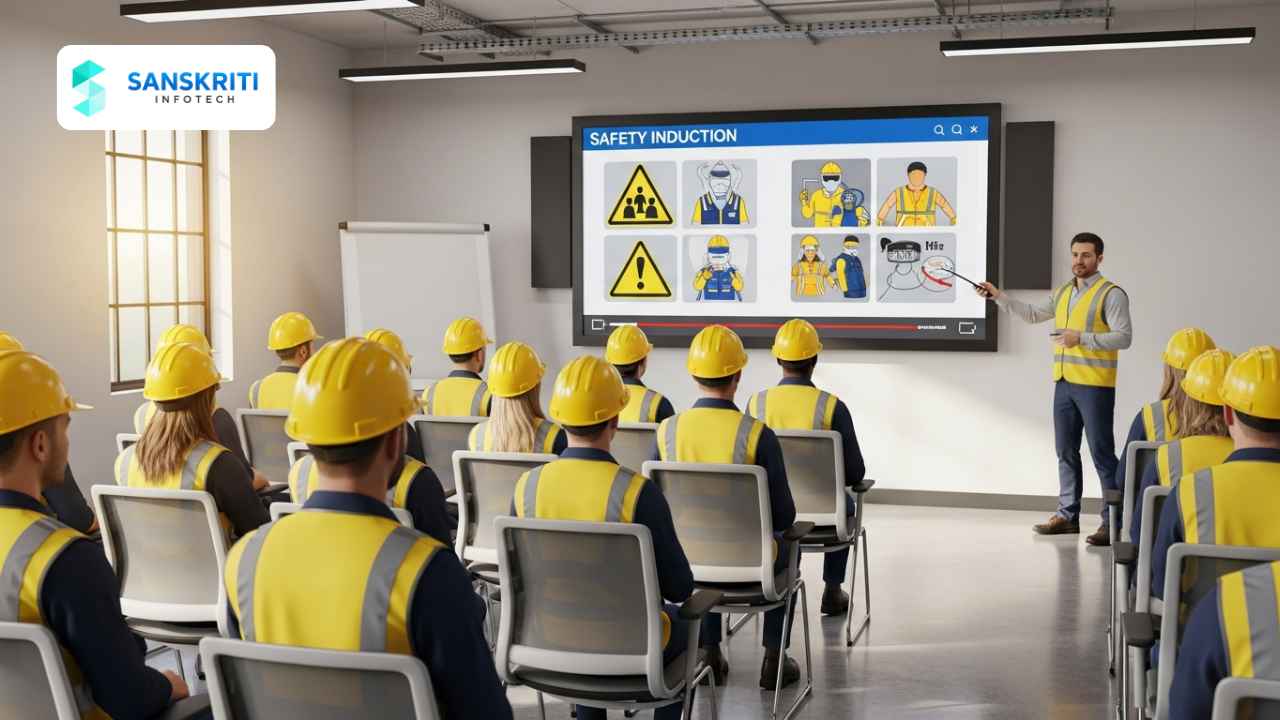Table of Contents
Introduction
Safety training often competes with production targets, shift changes, and information overload. To create lasting behavioral change, training must be memorable, relevant, and easy to apply on the job. Storytelling and animation together create an evidence-based way to capture attention, deepen understanding, and improve retention. This guide explains how organizations can design engaging safety training using storytelling techniques, animated content, microlearning modules, gamification, and measurable evaluation. It also explains practical implementation steps and shows how Sanskriti Infotech builds high-impact programs tailored to industrial clients.
Why Engagement Matters in Safety Training
Engagement is the bridge between knowledge and behavior. Unengaged learners forget procedures, skip steps, and are more likely to make errors. High-quality, engaging training reduces incidents, increases compliance, and supports a safety-first culture. For recommended training approaches and guidance, see OSHA.
Key outcomes of engaging safety training:
- Better knowledge retention
- Faster onboarding and reduced re-training
- Lower incident rates and near misses
- Higher reporting and proactive hazard identification
- Stronger alignment between SOPs and daily practice
1. Use Storytelling to Make Safety Training Human and Memorable
Storytelling frames safety information within a relatable narrative. Humans remember stories much better than disconnected facts. A good safety story includes a protagonist, a sequence of events, a mistake or hazard, and the resolution. This structure helps learners identify with the scenario and internalize lessons.
Practical tips for story-driven safety content:
- Use real incidents or realistic composites based on near-miss reports.
- Focus on decisions and consequences rather than abstract rules.
- Keep narratives short (60 to 180 seconds) for microlearning modules.
- Use diverse characters and situations to reflect your workforce.
- End with clear, actionable takeaways tied to SOPs.
UK HSE resources on behaviour-based safety provide further insights at HSE UK.
2. Leverage Animation to Visualize Risk and Procedures
Animation allows you to visualize invisible hazards, machine internals, airflow, chemical dispersion, and cause-effect chains in ways live-action cannot safely show. Whether 2D explainer clips, 3D process walkthroughs, or interactive simulations, animation brings clarity to complex procedures.
When to choose animation:
- High-risk or inaccessible environments (refineries, confined spaces, offshore rigs).
- Complex equipment where internal mechanics matter.
- Need for consistent global messaging across sites and languages.
- Scenarios that require safe demonstration of accidents or failures.
3. Combine Storytelling and Animation for Maximum Impact
Pairing narrative with animated visuals creates emotional engagement and cognitive clarity. A short animated vignette that shows a worker making a subtle error, the resulting near-miss, and the correct procedure delivers both affective and procedural learning.
Design pattern:
- Hook: Introduce a relatable character and a workplace context in the first 10 seconds.
- Conflict: Show the hazard or decision point.
- Resolution: Demonstrate the correct action and the positive outcome.
- Reflection: Provide a quick checklist and link to the SOP.
4. Use Microlearning to Respect Time and Boost Recall
Microlearning breaks content into small, focused bursts that are easier to consume and recall. For safety training, micro-modules can target single procedures, common near-misses, or role-specific hazards.
Best practices for microlearning:
- Keep modules under 5 minutes, ideally 60 to 180 seconds.
- Use a single objective per module.
- Include a 15 to 30 second knowledge check or interactive prompt.
- Deliver modules via mobile for just-in-time learning at the workstation.
Educational outcomes supported by research from NIOSH.
5. Apply Gamification Carefully to Increase Motivation
Gamification uses game elements such as points, leaderboards, challenges, and badges to motivate learners. In safety training, gamification can encourage hazard reporting, completion of modules, and participation in drills.
Design rules for safety gamification:
- Reward safe behaviors, not risky bravado.
- Use team-based challenges to build collective ownership.
- Keep rewards meaningful and simple (recognition, certificates, small incentives).
- Avoid metrics that encourage gaming the system; prioritize quality over speed.
6. Add Interactivity and Assessments to Reinforce Learning
Interactive elements such as hotspots, decision trees, branching scenarios, and short quizzes make training active rather than passive. Scenario-based branching helps learners practice decision-making and see consequences in a safe space.
- Use scenario-based assessments that mimic real decisions.
- Provide immediate, constructive feedback explaining why an answer is correct or incorrect.
- Track completion, scores, and time-to-competency in your LMS.
7. Make Training Accessible and Localized
To be effective across global teams, training must be accessible for language, literacy, and physical ability. Subtitles, multi-language voiceovers, simple language, and visual cues improve uptake.
Accessibility checklist:
- Provide subtitles and multiple language options.
- Use clear icons and avoid text-heavy slides.
- Ensure videos work offline for remote sites.
- Design controls and interactions that are usable on mobile devices.
8. Measure Impact and Iterate
Engagement alone is not enough. Measure training effectiveness using a mix of leading and lagging indicators. Leading indicators include module completion, assessment scores, and hazard reports. Lagging indicators include incident rates, near-miss frequency, and audit findings.
Practical measurement plan:
- Baseline assessment before rollout.
- Post-training knowledge checks.
- 30, 90, and 180 day follow-up assessments.
- Correlate training cohorts with incident data to evaluate behavior change.
9. Implementation Roadmap: From Pilot to Global Rollout
A pragmatic rollout plan reduces risk and proves value. Use a pilot-first approach, refine based on feedback, then scale.
Roadmap steps:
- Discovery: Gather SOPs, incident history, and audience profiles.
- Prototype: Produce a 60 to 90 second animated pilot linked to a microlearning module.
- Pilot: Test with targeted teams, gather qualitative feedback and performance metrics.
- Iterate: Improve script, visuals, and assessments based on pilot data.
- Scale: Localize, integrate with LMS, and schedule cadence for refresher modules.
10. Case Examples and Scenarios
Example 1: Confined Space Near-Miss
An animated vignette shows a technician failing to verify atmospheric checks before entry. The animation visualizes gas dispersion and the rescue sequence, followed by a micro-quiz. After rollout, the site reported a measurable increase in permit adherence.
Example 2: Forklift and Pedestrian Interaction
A short animated scenario highlights right-of-way, blind spots, and PPE. The module ended with an interactive hotspot that required the learner to identify hazards in a 360 scene.
Example 3: Chemical Spill Containment
A 3D animation demonstrates PPE selection, spill kits usage, and emergency isolation valves. The safe simulation allowed trainees to visualize plume behavior without exposure.
11. How Sanskriti Infotech Designs Engaging Safety Training
Sanskriti Infotech combines HSE expertise with animation craft to produce training that is technically accurate and emotionally engaging. We follow a people-first design that starts with the learner and ties every module back to SOPs and audit requirements.
Our service components:
- Discovery workshops with HSE and operations teams
- Scriptwriting and storyboard aligned with incident learnings
- 2D/3D animation, interactive hotspots, and branching scenarios
- Multilingual voiceover and LMS integration
- Measurement framework and refresher cadence
Aligned with international standards such as ISO 45001.
12. Addressing Common Objections
Objection: Animation is expensive
Response: While initial investment exists, animations reduce long-term training costs through reuse and easier updates. They also reduce incident costs, which typically exceed training investments.
Objection: Our workforce prefers hands-on training
Response: Animated modules are not a replacement but a supplement. They prepare learners so hands-on sessions focus on practice rather than explanation.





